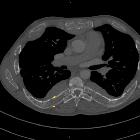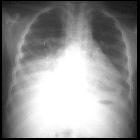thalassemia




























Thalassemia is an autosomal recessive hemoglobinopathy that originated in the Mediterranean region. The genetic defect causes a reduction in the rate of globin chain synthesis which causes the formation of abnormal hemoglobin molecules. The resultant microcytic anemia is the characteristic presenting symptom of the thalassemias.
Thalassemia is a quantitative problem of globin synthesis, whereas sickle cell disease is a qualitative problem of synthesis of an incorrectly functioning globin.
Pathology
Normal adult hemoglobin is composed of HbA (98%) and HbA2 (2%). HbA contains two α globin chains and two β globin chains, and HbA2 contains two α globin chains and two δ globin chains. They are arranged into a heterotetramer. Thalassemia patients produce a deficiency of either α or β globin, unlike sickle cell disease, which produces a specific mutant form of β globin.
The thalassemias are classified according to which chain of the hemoglobin molecule is affected. In α thalassemias, production of the α globin chain is reduced, while in β thalassemia production of the β globin chain is reduced.
The β globin chains are encoded by a single gene on chromosome 11; α globin chains are encoded by two closely linked genes on chromosome 16. Thus, in a normal person with two copies of each chromosome, there are two loci encoding the β chain, and four loci encoding the α chain. Deletion of one of the α loci has a high prevalence in people of African or Asian descent, making them more likely to develop α thalassemias. β thalassemias are common in Africans, but also in Greeks and Italians.
The thalassemia trait may confer a degree of protection against malaria, which confers a selective survival advantage on carriers.
Radiographic features
Skeletal
Marrow proliferation consists of an expansion of the medulla, thinning of cortical bone, and resorption of cancellous bone resulting in a generalized loss of bone density and yellow-to-red bone marrow reconversion.
- skull: the occipital bone is spared, due to lack of hemopoietic bone marrow
- hair-on-end appearance (classic)
- widening of the diploic space
- thinning of the inner and outer table
- facial bones
- rodent or chipmunk facies
- hypopneumatisation of the frontal, maxillary, and sphenoid sinuses, filled with marrow containing bone
- the ethmoid sinuses are spared due to lack of red bone marrow
- dental malocclusion
- ribs: rib-within-a-rib appearance, noted particularly in the middle and anterior portions of the ribs
- extremities: widening/expansion of the metacarpal and metatarsal shafts
- premature fusion of the epiphyses
- osteoporosis
- extramedullary hematopoiesis
Gastrointestinal: hepatobiliary
Lung
- diffusion impairment
- air-trapping
History and etymology
Named for the Greek word for "sea" (θάλασσα - thálassa), as the condition is more prevalent in those living around the Mediterranean Sea e.g. Italians, Greeks, etc. Cooley and Lee described bone abnormalities and severe anemia with associated splenomegaly in 1921 .
Siehe auch:
- extramedulläre Hämatopoese
- Sichelzellenanämie
- Cholezystolithiasis
- Hämosiderose
- Bürstenschädel
- Knochenmarksexpansion
- Kardiomyopathie bei Thalassämie
und weiter:
- Splenomegalie
- Osteomyelofibrose
- Auftreibung Metaphysen
- Hämochromatose
- dichte metaphysäre Bänder
- alternating radiolucent and radiodense metaphyseal lines
- Knochenmark
- Knochen-in-Knochen-Aspekt
- Erlenmeyer flask deformity of the femur
- Hereditäre Sphärozytose
- primäre Siderose
- Thalassaemia intermedia
- Auftreibung der Rippen
- Hämochromatose Manifestationen an der Leber
- MR imaging of abdominal lymphadenopathy in a patient with beta-thalassaemia major

 Assoziationen und Differentialdiagnosen zu Thalassämie:
Assoziationen und Differentialdiagnosen zu Thalassämie:


